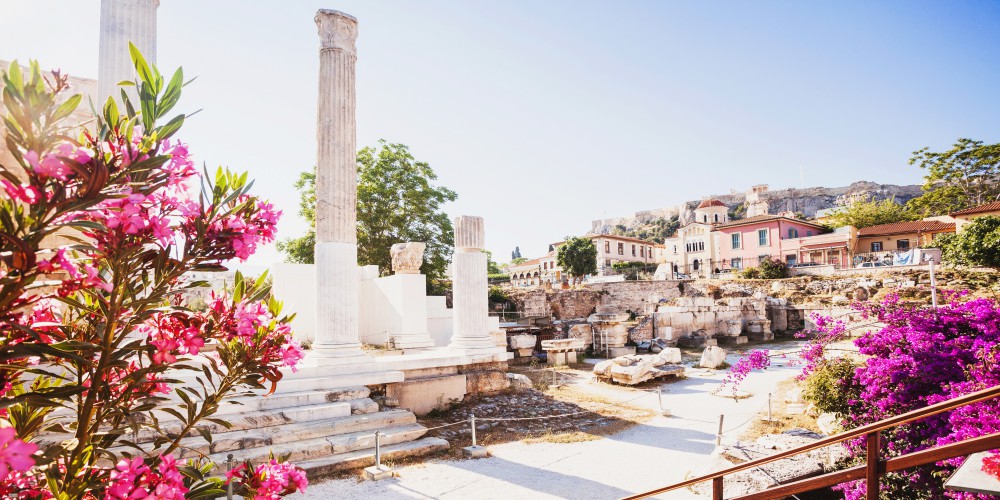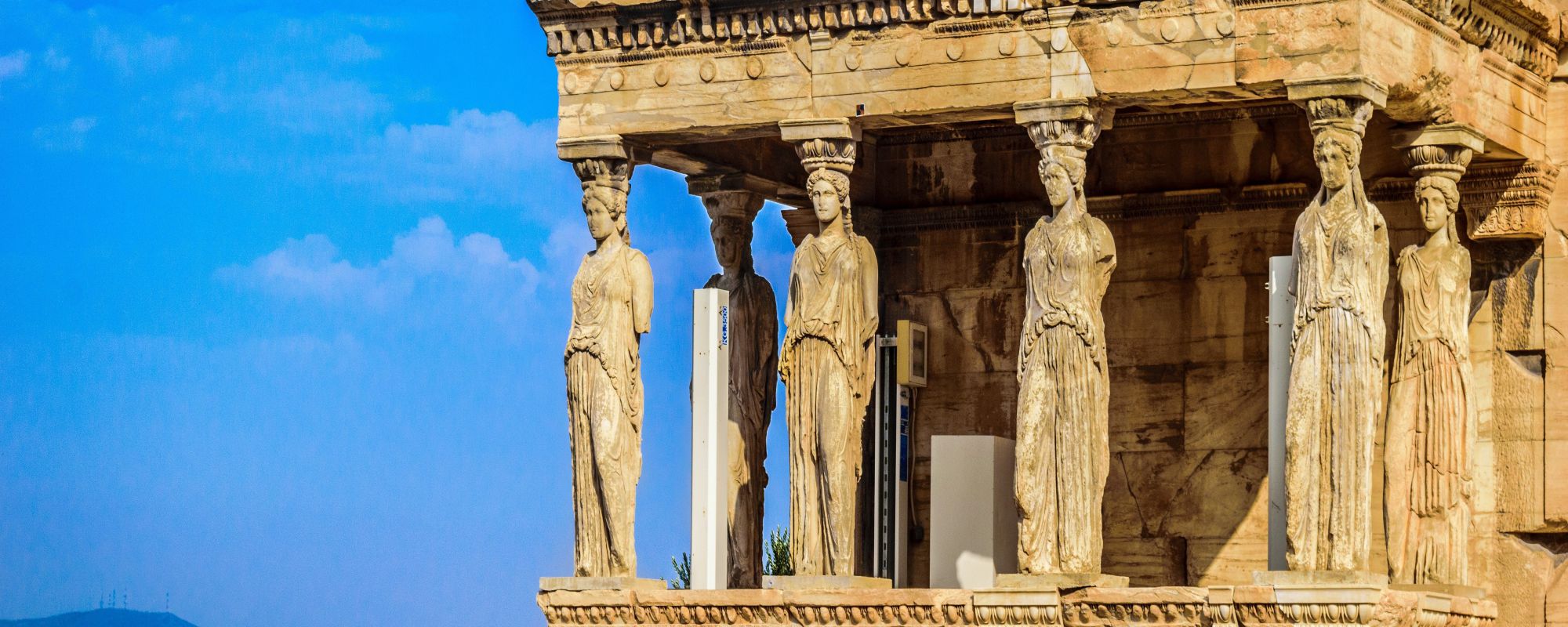
Athens Attractions | Create your Athens Bucketlist
Key Takeaways
- Athens is a diverse city with archaeological treasures and modern architecture. Athens attractions are never ending!
- The Acropolis Museum showcases rich history and artifacts of the Acropolis.
- The National Archaeological Museum houses extensive Greek art and antiquities.
- Stavros Niarchos Foundation Center offers a state-of-the-art cultural hub with a rooftop park.
Athens is a diverse city full of archaeological treasures and contemporary architecture.
From buildings that take you back in time, like the ones in the Temple of Olympian Zeus and the Ancient and Roman Agora, to landmark buildings hosting the Greek universities, or the modern, elegant Cultural Center of Stavros Niarchos, Athens has plenty of different attractions that will leave you speechless if you decide to prefer it over the Greek islands.
As the remarkable buildings are numerous, you have to know where to look for the ones that you should definitely visit, and it is very hard to do so without a Greece trip planner.
Here are the most important attractions of the Greek capital that will reveal to you the modern and ancient Greek civilization!
The Acropolis Museum
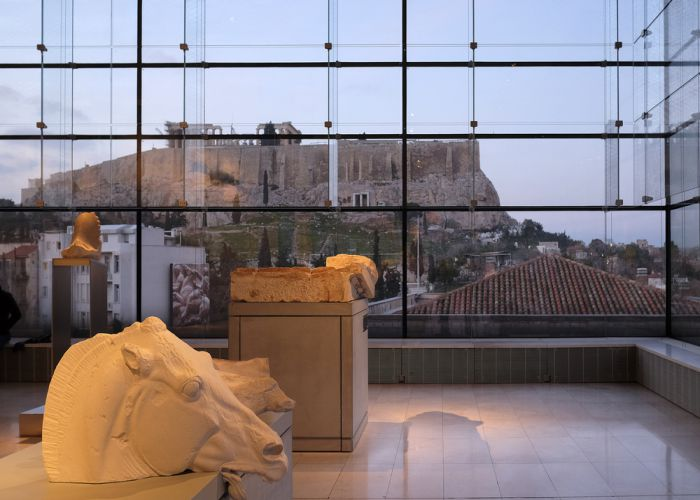 The Acropolis Museum - credits: serkan senturk/Shutterstock.com
The Acropolis Museum - credits: serkan senturk/Shutterstock.com
The new Acropolis Museum, located in Athens, Greece, is a world-renowned museum dedicated to showcasing the rich history and archaeological treasures of the Acropolis.
Designed by Swiss architect Bernard Tschumi and Greek architect Michalis Photiadis, the museum opened its doors to the public in 2009. It is situated just a few hundred meters southeast of the iconic Acropolis, providing visitors with a stunning view of the ancient citadel from its glass-encased galleries.
The Acropolis Museum houses an extensive collection of artifacts, sculptures, and architectural fragments that span over 2,500 years of Greek history.
The exhibits are thoughtfully curated and organized in chronological order, taking visitors on a journey through the various periods of ancient Athens, from the Archaic period to the Roman era.
The highlight of the museum is the Parthenon Gallery, which showcases the exquisite marble friezes and metopes that once adorned the Parthenon temple.
With its state-of-the-art facilities and modern design, the Acropolis Museum offers a captivating and immersive experience for visitors. The museum's architecture seamlessly integrates ancient ruins into its structure, creating a harmonious blend of the old and the new.
The National Archaeological Museum
 The National Archaeological Museum - credits: Lefteris Papaulakis/Shutterstock.com
The National Archaeological Museum - credits: Lefteris Papaulakis/Shutterstock.com
The National Archaeological Museum, located in Athens, Greece, is one of the most important museums in the world dedicated to ancient Greek art and archaeology.
Established in 1829, the museum houses an extensive collection that spans over 5,000 years of Greek history.
Its exhibits include a wide range of artifacts, from prehistoric times to late antiquity, including sculptures, pottery, jewelry, and frescoes.
The museum is particularly renowned for its collection of classical Greek masterpieces, such as the iconic bronze statue of Poseidon and the exquisite Mask of Agamemnon.
As visitors enter the National Archaeological Museum, they are greeted by a grand neoclassical building that houses the treasures within.
The museum's architecture itself is a work of art, with its elegant columns, ornate facades, and spacious halls. The exhibits are thoughtfully arranged and provide a comprehensive overview of Greek civilization, allowing visitors to delve into various aspects of ancient life, including religion, warfare, and daily activities.
Beyond its impressive permanent collection, the National Archaeological Museum also hosts temporary exhibitions that shed light on specific periods or themes within Greek history.
Additionally, the museum offers educational programs, lectures, and workshops, providing visitors with a deeper understanding of the artifacts and their historical context.
The Ancient Agora
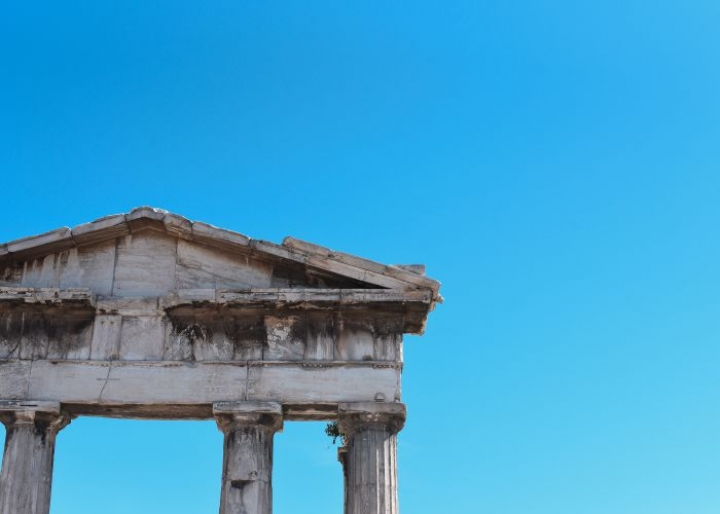
One of Greece's most significant archaeological sites lies right in the middle of the Greek capital’s city center and stands as a true example of ancient Greek culture and excellence.
The Ancient Agora of Athens, as it is called, due to its size, feels like it most often remains unexplored by the average visitor who only walks around its premises, hears a story or two, and moves on to the next site.
Let’s fix that. Here is an in-depth exploration of the ancient site of Athens' Ancient Agora, its history, and its important buildings that will introduce you to the everyday life of the locals of the ancient city of Athens.
History of Ancient Agora of Athens
The archaeological site of Athens' Ancient Agora - credits: kirkandmimi/Pixabay.com
In ancient Greece, the Ancient Agora used to be the center of the public life of the locals. The word ‘agora,’ meaning ‘market,’ comes from the verb ‘agorw,’ which in Greek translates to ‘I speak publicly.’ The word's etymology is related to the multifaceted role of the ancient Agora.
The Agora was the seat of administration, justice and the main place for trade and business. In the pre-classical years, the Agora was an additional gathering place for the Church of the Municipality, the people of Athens, and at the same time, a stage for theatrical competitions and sports performances.
In all eras, from the archaic years until 267 AD, when it got completely destroyed by the Heroes, the Agora was also a popular destination for the social and spiritual get-togethers of the Athenians.
Buildings of the Ancient Agora in Ancient Greek Times
Here is a breakdown of the public buildings and important monuments that the Ancient Agora used to host during its peak:
The Administrative Center of Ancient Athens in Ancient Agora
Ancient Agora - credits: Pixabay.com
Tholos: A circular building that was the social seat of the democratic administration of the 50 Rectors, who each ruled for one-tenth of the year (36 days).
Every day in ancient Athens, a draw took place to decide the head of the Rectors, whose term would then only last for 24 hours.
In the building of Tholos in Athens Ancient Agora, prior to the meetings, the co-rectors used to make sacrifices to the god Apollo and goddess Artemis, who were worshipped there along with the Phosphores, chthonic lower deities who protected the public life of Athens.
The Ancient Detention Center, also known as ‘Socrates’ prison’: About 100 m from the southwestern end of the Agora, among the ancient ruins of houses and laboratories, a crippled public building has been identified as the place where the Detention Center of classical times was located. Any building material at the site is scarce due to burglary.
Among the findings the first excavations brought to life, there are 13 very small vessels, perhaps used to store the venom for those sentenced to death.
A worn-out statuette of Socrates was also found; this, along with the Platonic Dialogues and Plutarch testimonies, suggests that this is where Socrates was kept and where he eventually left his last breath.
Vouleftirion: In the archaic years, the deputies met in the open space of Vouleftirion, the name of which translates to ‘Parliament’ in Greek. In the Classical Era, the Parliament consisted of 500 deputies, which is why Greeks usually refer to it as ‘ the Parliament of Five Hundred.’
For the Parliament to form, each of the ten tribes of Athens selected 50 of its representatives by drawing a lot. The term of each member of the Parliament lasted for one year.
Mitroo: A building that dates back to Hellenistic times, Mitroo used to be the registry of Athens. All the votes, written on papyrus, leather, or wooden boards, were deposited there, along with any other official documentation of the ancient times. The State of Athens hired a special officer to arrange and store these documents.
In the same building where the public documents were kept, people also used to worship the Mother of Gods Rea - Kyvelis, which is why the great goddess used to be depicted in Greek Mythology as the ‘guardian’ of the archives.
The Temple of Apollo Patroos: A small Ionian temple built during the 4th century BC and dedicated to "Patroos" Apollo, father of Ionas, ancestor of the Ionians, and therefore of the Athenians.
Apollo Patroos was one of the patron deities who protected the organization of the Athenian state and was associated with the Athenian fraternities.
Ancient Agora - credits: Vania Tonova/Shutterstock.com
The Temple of Fratrius Zeus and Athena Fratrias: These adjectives that were given to the gods come from the word ‘fratir,’ which means ‘brother,’ and were given to Olympian Zeus and Athena because they were worshiped as gods-protectors of the Athenian fraternities.
In front of the entrance of the neighboring temples of Patroos Apollo, Zeus Fratrios, and Athena Fratrias, was the altar to which the members of each Athenian fraternity commonly offered sacrifices to honor their patron deities.
The Stoa of Eleftherios Zeus: A place of rest for the Athenians with wonderful paintings by painter Euphranoras. It was built in the 5th BC.
Vassilios Stoa: Also built in the 5th century BC, Vassilios Stoa can now be seen buried under the train tracks of the modern train of Athens.
Ancient Agora - credits: Tatiana Popova/Shutterstock.com
It was the seat of the king of Athens, who only had religious and judicial power. Here, there were inscriptions with all the laws of the Athenian state from the time of Solon onwards.
Pikili Stoa and Ermon Stoa: On the north side of Athens' Ancient Agora were the Pikili Stoa and Ermon Stoa.
Pikili painted Stoa included magnificent paintings by painter Polygnotos, such as the one depicting the battle of Marathon. In addition, it gave its name to Stoic philosophy since its founder, Zeno, taught here.
Altar of the Twelve Gods: The Altar of the Twelve Gods in the Athenian Agora was built in the sixth century BC and served as a starting point for measuring distances.
Central Area
Ancient Agora - credits: PavleMarjanovic/Shutterstock.com
The Temple of Areos: Probably the work of the unknown architect who also built the Temple of Hephaestus in Thission during the middle of the 5th century BC.
Initially, the Temple of Areos was located in the Athenian district of Acharnes, but it was transferred to the Agora by the order of the emperor Augustus.
In front of the pile of ruins of the temple lies the Complex of tyrant-killers Armodios and Aristogeitonos, who killed the tyrant Hipparchus, an act that eventually led to the liberation of classical Athens from the tyranny of Peisistratus and, therefore, to the creation of the free republic. The Athenians loved the two killers; the area was considered sacred and a place of immunity.
The Monument of Famous Heroes: Long pedestal with a railing of the 5th century BC on which the citizens rested.
The statues of the heroes of the ten tribes were erected at the monument. It was the information center of the Athenians, as that was where public announcements were hung.
The Galleries (South I - South II - Middle gallery): Built from the 5th to the 2nd century BC, the Galleries had shops, offices, and banquet halls.
Near the Middle Stoa, the findings of a shoe factory were discovered, attributed to the popular shoemaker of the time, Simon, a friend of Socrates, who, according to Xenophon, was frequented by the Athenian philosopher.
Ancient Agora - credits: Pixabay.com
The Agrippa Conservatory: As its name suggests, the Conservatory was built by Agrippa in 15 BC, with a capacity of 1,000 spectators and a two-story gallery.
The large open gallery was supported by giant statues of tritons and giants. The sculptures used to mimic the enormous trunk of Poseidon from the western pediment of the Parthenon.
The Conservatory suffered severe damage in the middle of the 2nd century AD, and although it was rebuilt immediately, it was destroyed yet again in 267 AD, rebuilt during the 4th century AD, and finally abandoned during the 5th century.
Eastside
Attalos Gallery: A two-story gallery consisting of shops, which was built by King Attalus II in honor of his teacher, a Stoic philosopher, Carneadus, and the Athenians.
The gallery is 116m long. The ground floor columns have been built in the Doric style, while the floor columns follow the Ionic style.
It was completely restored in the 1950s by the American School of Archeology, which since 1931 has been conducting excavations in the Ancient Agora.
The Stoa now functions as a museum. The exhibits were found in the excavations of the Ancient Agora and give a representative picture of the democratic practices of ancient Athens.
Panathinaion Street: It used to start from the district of Keramikos, pass in front of the Stoa of Attalos and the Elefsinio, and end at the entrance of the Acropolis.
It was the route of the procession of the Panathenaic Games, the most significant celebration of the Athenians in honor of their patron goddess.
Ancient Agora - credits: Pixabay.com
Every four years, during the summer, the Athenians, led by the leadership and the wheeled trireme (which carried the goddess's veil), went up Panathinaion Street and walked on the Acropolis. This majestic procession is depicted on the frieze of the Parthenon.
The Church of the Holy Apostles of Solakis: One of the most beautiful and earliest temples of the medieval era is the Church of the Holy Apostles of Solakis.
It dates back to around 1,000. It is a four-column cruciform with side niches. The exterior walls have a beautiful false ceiling decoration.
The Samuel M. Kress Foundation in New York restored it to its original form, and you can admire the Church of the Holy Apostles in Athens today.
Pantainos Library - Late Roman Wall - Elefsinio: On Panathenaic Street, towards the Acropolis, on the southeast side of the marketplace, we see traces of the walls that were built shortly after the destruction caused in 267 AD.
Nearby was the famous Elefsinio, the Athenian branch of the great mosque of Demeter and Persephone in Elefsis.
Together with the Parthenon and Thissio, it was one of the most revered shrines in classical Athens. Every year, the day after the celebration of the Eleusinian Mysteries, the ‘Parliament of Five Hundred’ met in this place.
The Temple of Hephestus in Ancient Greece
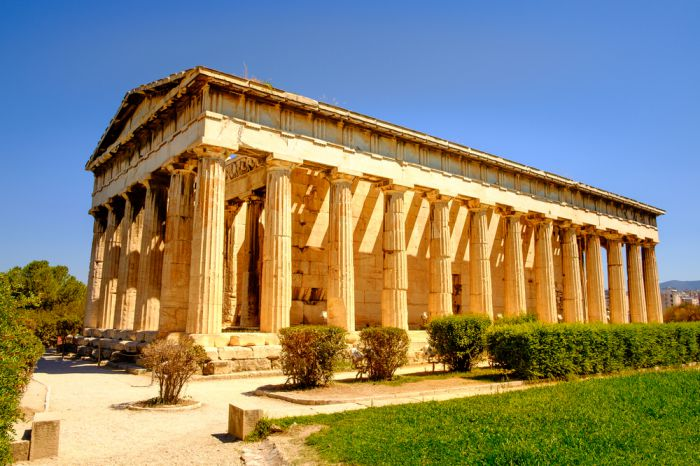 The Temple of Hephaestus - credits: Martin M303/Shutterstock.com
The Temple of Hephaestus - credits: Martin M303/Shutterstock.com
In the Ancient Agora lies the temple of Hephaestus, one of antiquity's most beautiful Doric temples.
It was built in 449 BC and was dedicated to two gods, the god Hephaestus, patron of metallurgy, and the goddess Athena Ergani, patroness of the arts.
According to the characteristics of the building, the architect who undertook its construction was significantly influenced by the Parthenon.
Its architect remains unknown, but he is also said to have been the creator of the magnificent temples of Poseidon in Sounio, Nemesis in Ramnuda, and Aris in Acharnes.
It was built on the hill of Agoraios Kolonos, and its surroundings were decorated with clay pots with flowers and shrubs. Inside were the two bronze statues of Hephaestus and Athena, which were destroyed.
It is a Doric pavilion temple with rich sculptural decoration made of Parian marble. The deeds of Hercules in the north and the deeds of Theseus are represented in the eastern metope.
The frieze of the pronaos represents the battle of Theseus with the Pallantides and, in retrograde, the battle of the Lapiths and the Centaurs.
Marble sign on the archaeological site - credits: Pixabay.com
The temple has been preserved in good condition until today in the modern Greek state, largely due to the fact that in the 7th century, it was converted into a Christian church.
The temple of Hephaestus became the church of Saint George of Akamatis. The coronation of King Otto took place in Saint George when he came to Athens in 1834. Later, it became the Archaeological Museum of the newly formed state.
With the Asia Minor Catastrophe and the influx of thousands of refugees into the country, the agora area around the temple had been turned into a refugee camp.
All activities stopped at the beginning of the 20th century as the first archaeological excavations began.
If you are one of those people who love observing the buildings while walking the streets of a foreign city, this will be a treat!
Here is a list of 15 outstanding buildings in our city that we believe will give you a better insight into Athens' secrets.
National Technical University of Athens
- Year: 1862-1957
- 42, Patission St.
The National Technical University of Athens - credits: https://goo.gl/dmh37g
The construction of the building transpired in three stages due to the need for more auditoriums: between the years 1862-1876, 1930-1935, and 1950-1957.
This building complex and the student uprising against the junta go hand in hand in Greek history.
In fact, the uprising against the military dictatorship began on November 14, 1973, and ended on November 17, 1973, when a tank entered the university after breaking down the central gate.
The invasion resulted in the murder of hundreds of students who were standing behind the gate, cheering slogans about freedom.
This is the greatest uprising in the modern history of Greece, while the broken gate is still there, lying on the floor behind the new gate, as historical memorabilia.
Technopolis
- Year: 1860-1914
- 100, Peiraios av. & 1,Persefonis
Technopolis (Gazi), Kerameikos - credits: Heracles Kritikos/Shutterstock.com
In 1860, the first gas installation in Athens was built in the area of Gazi, with the Athenian neighborhood being named after the installation.
During the late years of the 19th century, Technopolis kept expanding, and in the middle of the 20th century, it hosted wood factories, blacksmiths, machining centers, repair garages, reservoirs, furnaces, and many more buildings.
Today, it is one of the most popular venues in Athens. Numerous musical and cultural events have taken place in this area since 1999, and it is one of the most favored places for concerts, especially during the summer and autumn.
Hotel Mpageion
- Year: 1890-1894
- 18, Omonoia sq. & Athinas St.
Hotel Mpageion - credits: lifo.gr
Luxury hotels in Athens go way back! Erst Ziller was the one who made the designs for the Mpageion, Hotel, which was built during 1890-1894.
What is really impressive about this building, however, is that despite the decline of the hotels following WWII, Mpageion was the only one that remained open until 1969.
Iliou Melathron
- Year: 1878-1880
- 12, Panepistimiou st.
Iliou Melathron - credits: gtp.gr
Iliou Melathron is an iconic Athenian building that was designed in 1879 by E. Ziller. It was restored in 1984 as well as in the first years of the 21st century.
Today, it hosts the Monetary Museum of Athens, and in case you decide to visit the museum, you‘ll have the chance to admire the impressive interior of this outstanding neoclassical building.
Panepistimio Athinon (University)
- Year: 1839-1864
- 30, Panepistimiou st.
University - Panepistimio Athinon - credits: Anastasios71/Shutterstock.com
Panepistimio is part of the Neoclassical Trilogy that includes the Academy, University (Panepistimio), and Library of Athens, and it is undoubtedly one of the highlights of Athens.
Both locals and visitors who happen to be in the area surrounding Panepistimio love gazing at these buildings that are so impressive that inspire awe for the previous generations who created these architectural treasures.
The architectural masterpiece of Panepistimio was designed by C. Hansen.
74th Primary School, Athens
- Year: 1875-1876
- 106-108, Andrianou st.
The 74th Public Primary School of Athens - credits: https://goo.gl/jguC8K
The 74th Primary School is probably one of the most beautiful public schools in Athens. It was designed by the Greek architect P. Kalkos.
It is noteworthy that the Doric columns and the classical pediment of this building run counter to its small scale.
Villa Ilissia
- Year: 1840-1848
- 22, Vasilisis Sofias av.
Villa Ilissia- credits: Leonid Andronov/Shutterstock.com
Villa Ilissia -or 'Megaro of Ilisia'- is an idiosyncratic two-story building in which elements of Classicism and Romanticism coexist in harmony.
It used to be the house of Sophie Lebrun (also known as Duchesse de Plaisance) until 1854.
After the death of Lebrun, it was used as a building for military services until becoming the host of the Byzantine Museum of Athens.
Interwar block of flats
- Year: 1927
- 55, Vasilisis Sofias av.
Interwar building in Vas. Sofias Avenue - credits: https://goo.gl/EqxSDC
K.Kitsiki was the architect of this interwar block of flats.
Having graduated from the Berlin-Charlottenburg school, he created this distinct building, promoting the association of old and new forms; it is deemed as a typical ''erker'' building due to the protruding volumes.
Church of Agioi Anargiroi ('Agiotafitiko Metochi')
- Year: 1601-1650
- Pritaneiou & Erechtheos st.
Agiotafitiko metochi (church of Ag.Anargiroi) in Plaka - credits: Dimitris Kamaras/flickr.com
This church is a basilica church that was built during the Ottoman Rule.
In the 17th century, it was the property of a family named Kolokinthi, while it has been part of the property of the Greek Orthodox Patriarch of Jerusalem since the 18th century.
It also speculated that it was used as a female monastery during the 17th century.
Church of Agios Nikolaos, Ptochokomeion (workhouse)
- Year: 1876
- Vasilisis Sofias av. & Ploutarchou
The church of Agios Nikolaos was built in 1876 - credits: Dimitris Kamaras/flickr.com
The workhouse of Athens was founded by the 'Almoner Company,' and it was finally established in 1876 thanks to the donation of Andreas Syngrou.
The building of the foundation no longer exists, but fortunately, the church of St. Nicholas, which was then built inside the enclosure, is preserved.
It is a domed cruciform church designed according to the rules of Neo-Byzantine architecture.
The Athens Tower
- Year: 1970-1973
- 2-4, Mesogeion Av.
Athens Tower - credits: PitK/Shutterstock.com
To be honest, it is probably one of the ugliest buildings in Athens. However, it is remarkable for being the first skyscraper in the city, with the Athens Tower still being the tallest building in Greece to this day!
The refugee housing complex
- Year: 1933-1935
- 165-169, Alexandras av.
The refugee housing complex - credits: greekreporter.com
The refugee housing complex in Alexandra Avenue is one of those sights of Athens that break your heart.
The buildings were constructed during 1933-1935 as part of the Welfare Ministry's plan to accommodate the myriad refugees from Asia Minor who had flooded Athens and Greece.
That's how this building complex came to be, with a total of 228 apartments distributed in eight apartment buildings, which were arranged to be superimposed on each other and parallel to the axis of the avenue.
They are strictly utilitarian buildings, according to the rules of German Functionalism, without a trace of decoration.
Despite their bland look, however, just traces of the bullets of the 'Dekemvriana,' a series of clashes fought during World War II in Athens –from 3 December 1944 to 11 January 1945 – between the Greek left-wing Resistance forces and the British Army supported by the Greek Government, can be found on the walls.
In 2007, 90 out of 228 apartments were still inhabited, while the rest of them had been acquired by the municipality of Athens in view of the regeneration of the wider area.
Ophthalmiatrion
- Year: 1847-1869
- 26, Panepistimiou st. & Sina St.
Ophthalmiatrion Ahinon, Panepistimiou St.- credits: odosell.blogspot.com
The construction of the building of Ofthalmiatrio (eye center) first began in 1847 under the authority of Hansen.
However, he quit when the construction was paused and postponed due to financial difficulties. Thus, the better part of the building was built under the leadership of L. Kaphtatzoglou.
What makes this building truly remarkable is the fact that it is in marked contrast to the imposing Neoclassical Athens Trilogy (Academy – University – Library), which is located in the same street.
Tzistarakis Mosque
- Year: 1759
- 1, Areos st & Pandrosou, Monastiraki sq.
Tzistarakis Mosque - credits: trabantos/Shutterstock.com
According to tradition, in the construction of this Muslim mosque, a column from the temple of Olympian Zeus was used.
Yet, scientists believe that the column which was used in its building was probably taken by the adjacent Library of Roman emperor Hadrian.
Today, Tzistarakis Mosque houses a branch of the Museum of Greek Folk Art. In 1966, the building was remodeled in order to be used by the exiled king of Saudi Arabia for praying.
National Observatory of Athens
- Year: 1843-1846
- Nimfon hill
National Observatory of Athens - credits: Dimitrios/Shutterstock.com
The neoclassical building of the National Observatory of Athens was built in 1843, but the inauguration took place in 1846.
Hansen was -once again- the architect of the building, and George Sina was the generous businessman who funded both the construction and the equipment purchase of machinery and implements.
The reason why the National Observatory was built on the Hill of the Nymphs instead of Lycabettus, which was the initial option, is that, according to legend, Athenian astronomer Meton used to observe the stars from the former location.
Stavros Niarchos Foundation Center (SNFC)
Stavros Niarchos - credits: Milan Gonda/Shutterstock.com
Nestled on the edge between the busy commercial area of Kallithea and Faliro, lesser-known neighborhoods of the Athens Riviera stand a cutting edge, an architectural homage to the symbiotic connection between nature and man.
It is a demonstration of vision and philanthropy gifted to Athens by a man who used his wealth to enrich the lives of others.
The Stavros Niarchos Foundation is beloved by many of the city’s locals and, whilst largely unknown by tourists, it is absolutely worth the time taken to visit. By day or night, it is a truly breathtaking experience.
What is SNFCC
After such a grand introduction, you might wonder what exactly is the Stavros Niarchos Cultural Centre. It is an ambitious project to provide a new state-of-the-art home for the National Library of Greece and the Greek National Opera, as well as a vast ever-green rooftop park and ground-level sweeping esplanade.
Its long-term goal is to provide the nation with a library that gives access to a world of knowledge and to be at the heart of a network of libraries across Greece holding worldwide connections.
The architecture of the building itself reflects the aspirations of a project of such magnitude. Glass walls, impressive staircases, and commanding views across Athens leave you feeling enlightened!
Greek National Opera - credits: PitK/Shutterstock.com
A visit to the center will convince you that it truly is a wonderful gift to the general public. A perfect spot to take a stroll or browse a seemingly never-ending library of books, the foundation center also boasts of music, film, sporting, and child-focused events, all of which are free but may require prior registration.
If you are visiting Athens during the summer months, be sure to check the Stavros Niarchos Foundation website so you are updated on the events, activities, and music festivals it hosts.
The rooftop park is nothing short of a verdant paradise. Perfect for children to play in, with its labyrinth of flora and fauna, fountains, alcoves, and open areas.
During summer, a large screen is erected with movie nights offering both cult, classic, and new releases.
On the ground level lies an expansive esplanade that runs alongside a striking canal feature that hosts rowing boats, kayaking, and sailing dinghies on certain days.
Daily, people can be seen biking, running, and walking dogs, as well as activities organized by the foundation, such as pilates, yoga, and dance classes. Bikes are available to hire for 3, 5, 10, and 20 hours at €3, €5, €10 & €20, respectively.
Alternatively, relax by the canal while watching the Dancing Fountains, a spectacular water show, every half an hour. The swiveling fountains, along with the dazzling led lights and the enchanting music, will mesmerize you.
If you visit Greece on Christmas and you find yourself in Athens, visit Stavros Niarchos Center for some fun on the ice skating rink situated in the Canal.
Operating daily from December to the end of February, people of all ages are welcome to have fun while ice skating. It is free of charge, but you need to book a slot in advance.
Considering the array of activities, it is possible to spend the entire day at the Stavros Niarchos Center.
Free WIFI is available throughout the area, with access to computers allowing browsing of over 5,000 magazines and newspapers from 100 countries in 60 different languages!
How to get to Stavros Niarchos Cultural Center
If you don’t have a car, fear not because, with frequent buses, trams, and the Athens Metro, it is relatively simple to access the Stavros Niarchos Cultural Center.
If you truly wish to discover Athens like a local, the Stavros Niarchos Centre deserves to be at the top of your list of things to do in Athens. Find more hidden treasures, known and loved by locals, on one of our walking tours of Athens.
Add the cultural center to your Athens itinerary by joining our Sounion Day trip and opting for a Stavros Niarchos Foundation stop.
Final Thoughts
These are just a few of the noteworthy attractions and buildings to marvel at when visiting Athens, the hub of Western civilization.
Athens is a historic city where one can find architectural treasures of different centuries and remnants of ancient ages mere meters away from each other, making for the perfect tourist attraction.
These buildings' presence is moving and definitely impressive for anyone who is interested in learning the story of Athens.
Of course, there are many more, like the Benaki Museum or the Panathenaic Stadium, which hosted the first modern Olympic Games. However, these are just our top picks.
We collected the main attractions of our favorite city that we believe you should not miss! What are you waiting for? It’s as if you’ve just become your own guide! We hope you enjoy your visit to the most iconic landmarks of Athens.









